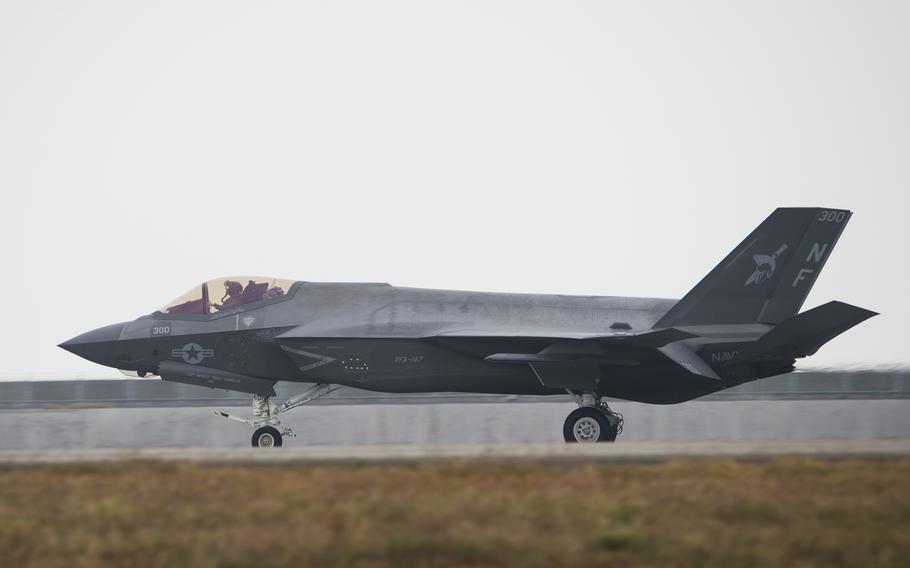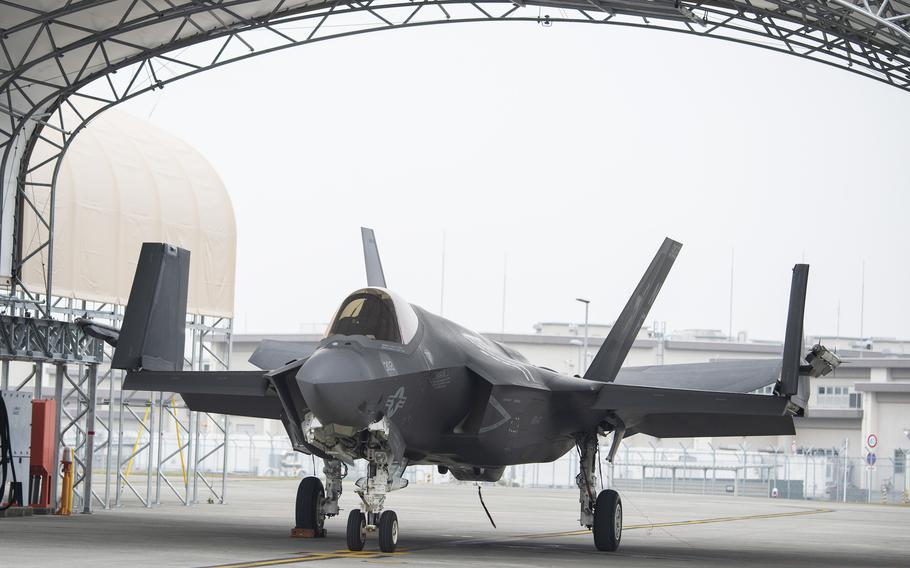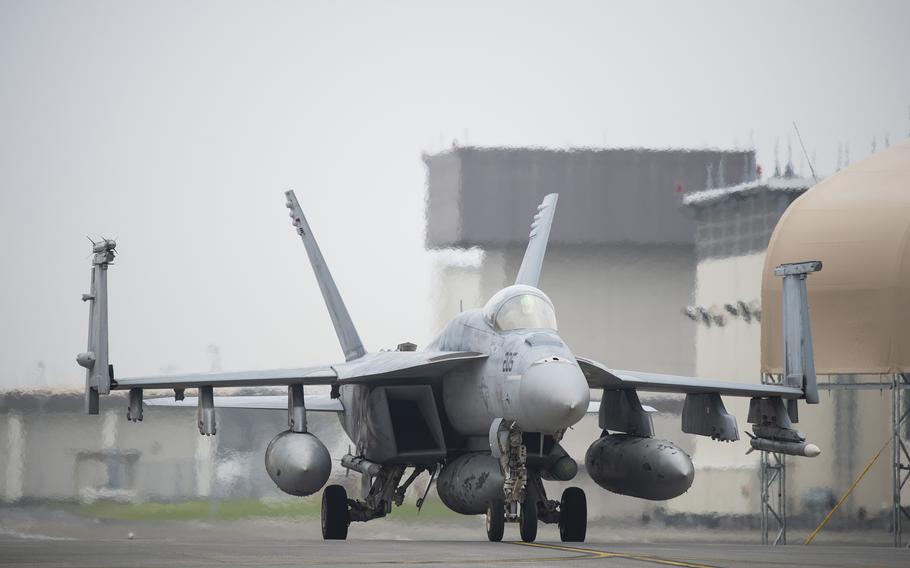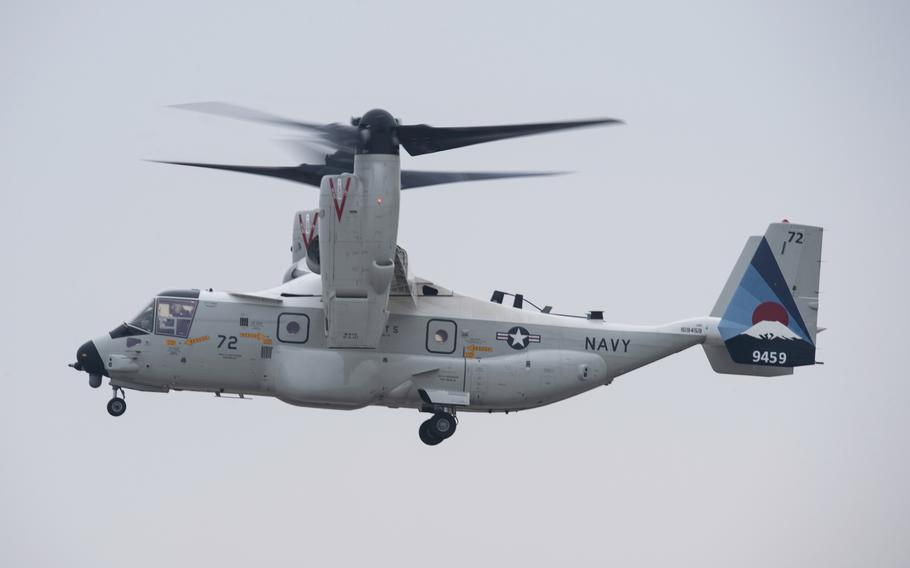
An F-35C Lightning II with Strike Fighter Squadron 147 lands at Marine Corps Air Station Iwakuni, Japan, Nov. 17, 2024, after a deployment aboard the USS George Washington. (Jonathan Snyder/Stars and Stripes)
MARINE CORPS AIR STATION IWAKUNI, Japan — Carrier Air Wing 5, the aviation arm of the USS George Washington, arrived home Sunday at this air base with a new addition, a squadron of advanced F-35C Lightning II multirole fighters.
Strike Fighter Squadron 147, the Argonauts, is the first unit of F-35C aircraft stationed in Japan, although other variants of the Lightning II are well-known here, squadron commander Cmdr. Christopher Case told Stars and Stripes during a flightline briefing.
“With the F-35B that has operated in Iwakuni for quite some time and then with Japan getting their own F-35A/B, the F-35 program is not new to Japan,” he said.

An F-35C Lightning II with Strike Fighter Squadron 147 parks at Marine Corps Air Station Iwakuni, Japan, Nov. 17, 2024, after a deployment aboard the USS George Washington. (Jonathan Snyder/Stars and Stripes)
The C variant of the fifth-generation fighter is equipped with larger, foldable wings and arresting gear designed for arrested landings. Its additional fuel capacity allows it to fly farther and longer than other variants, according to its maker, Lockheed Martin.
Otherwise, the F-35C is very similar to all the other F-35 models in its capabilities, maintenance requirements and the noise it makes, Case said.
The 147th replaced the F/A-18E Super Hornets of Strike Fighter Squadron 115, one of a broader upgrade of U.S. fighter aircraft stationed in Japan.
“We are essentially a very similar overall footprint to the squadron that just left,” Case said. “What we bring is effectively a very similar footprint in terms of both aircraft numbers as well as folks and the families that are over here with us.”
An F-35C assigned to the 147th made history Oct. 2 as the first to land on the George Washington while deployed to the U.S. 7th Fleet, according to the Navy.
Squadron aircraft also flew from the carrier as the George Washington made its way around Central and South America earlier this year en route to its new posting at Yokosuka Naval Base, Japan, the Navy said Nov. 5. The carrier is expected there soon.

An F/A-18E Super Hornet with Strike Fighter Squadron 195 taxis at Marine Corps Air Station Iwakuni, Japan, Nov. 17, 2024, after returning from a deployment on the USS George Washington. (Jonathan Snyder/Stars and Stripes)
Another new Navy unit in the carrier wing, Fleet Logistics Multi-Mission Squadron 30, with four CMV-22B Ospreys, arrived at MCAS Iwakuni on Nov. 9, squadron pilot Lt. Blake Barber told Stars and Stripes on the flight line Sunday.
The CMV-22B — the Navy’s version of the Osprey — carries cargo and personnel to and from the carrier and replaces the C-2A Greyhound. The aircraft’s larger fuel tanks give it longer range, and its tiltrotor engines allow it to take off and land vertically from the flight deck like a helicopter but fly with the speed of a fixed-wing plane.

A CMV-22B Osprey assigned to Fleet Logistics Multi-Mission Squadron 30 takes off from Marine Corps Air Station Iwakuni, Japan, Nov. 17, 2024. (Jonathan Snyder/Stars and Stripes)
However, a series of fatal accidents shadowed the Osprey until Nov. 29, when an Air Force CV-22 crashed offshore of southern Japan, killing all eight aboard. All U.S. and Japanese military Ospreys were grounded for three months during the accident investigation. The aircraft were cleared to fly again in March.
Barber referred questions about the Osprey safety to the Navy’s Task Force 70.
“We will support the carrier whenever it needs us to,” he said. “Otherwise, we will be conducting training missions.”